Reverb and delay are two of the most essential effects in the music production world.
They can profoundly transform the texture and atmosphere of a track, adding depth and dimension, as well as rhythmic complexity and spatial awareness.
So, as a music producer, it’s important to know all about reverb and delay to utilize them effectively.
Plus, it helps you to creatively enhance your music and achieve professional-quality sound.
In this article, we’ll be breaking down:
- Reverb vs delay: everything you need to know ✓
- Types of reverb (and how to use reverb) ✓
- Exploring different delays (and how to use delay) ✓
- Physical space and time-based effects ✓
- Combining reverb and delay ✓
- When to use reverbs or delays ✓
- Technical insights on settings and plugins ✓
- Creative techniques for mastering effects ✓
- Tailoring effects for different instruments ✓
- Much more about reverb vs delay ✓
By the end of this article, you’ll know the difference between reverb and delay.
You’ll be equipped with the knowledge to manipulate these effects to suit any musical context and enhance your mix.
As well as create soundscapes with the precision and flexibility of a professional.
So, let’s explore reverb and delay…
Table of Contents
- Understanding Reverb vs Delay
- Different Types of Reverbs
- Different Types of Delays
- Reverb vs Delay: The Key Differences
- Physical Space vs Time-based Effects
- Strategies for Blending Reverb and Delay in a Mix
- Understanding Reverb and Delay Settings
- Delay Plugins
- Digital Reverbs & Reverb Effects
- How To Tailor Effects to Different Instruments: Guitar, Voice, etc.
- 3 Creative Techniques For Mastering Reverb and Delay
- Reverb vs Delay: Final Thoughts
Understanding Reverb vs Delay
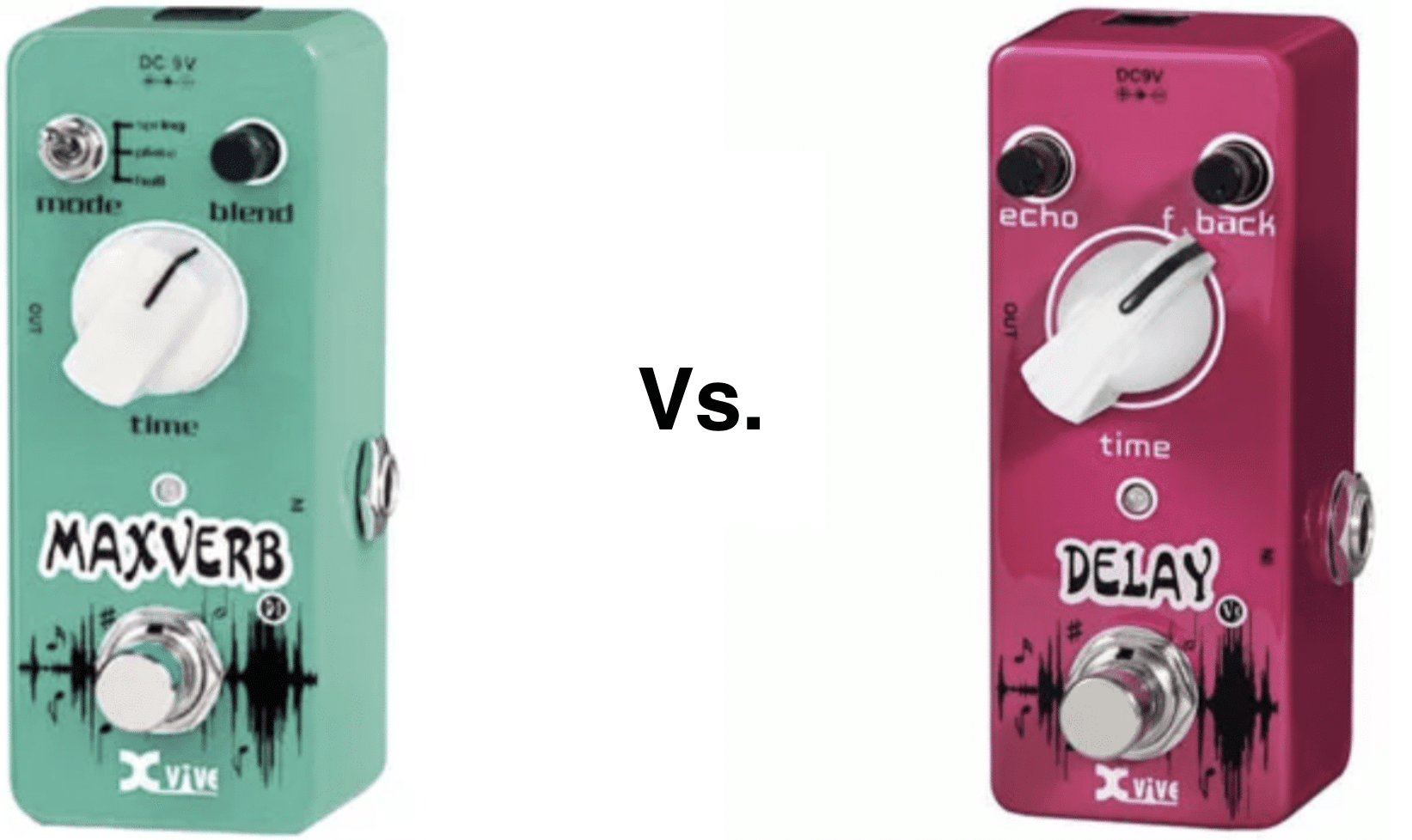
As a digital music producer, you’re constantly experimenting with various elements to create the perfect sound.
Among these, the concepts of reverb and delay stand out as fundamental tools.
Reverb vs delay (though often used interchangeably) are distinct in their impact on music production.
- Reverb simulates the sound of space 一 reflecting back sound waves to create a sense of a physical environment.
- Delay repeats the original sound 一 introducing echoes and time-based effects.
When adding reverb or exploring reverb in your mix, you’re essentially simulating the acoustic characteristics of different spaces.
Whether it’s a large room or a subtle spring reverb, the goal is to add depth and dimension to your tracks.
In contrast, using a delay pedal or delay settings, you manipulate time, creating rhythmic patterns and distinctive echoes.
It can transform a simple guitar sound into something complex and layered.
Understanding these differences is crucial, as they directly influence how you approach your mix and help you decide whether to incorporate delay or reverb.
The use of reverb and delay can make or break a track.
For instance, a guitar part might need more reverb to convey a sense of space, while a vocal track might benefit from a subtle delay to enhance its presence in a song.
Different Types of Reverbs
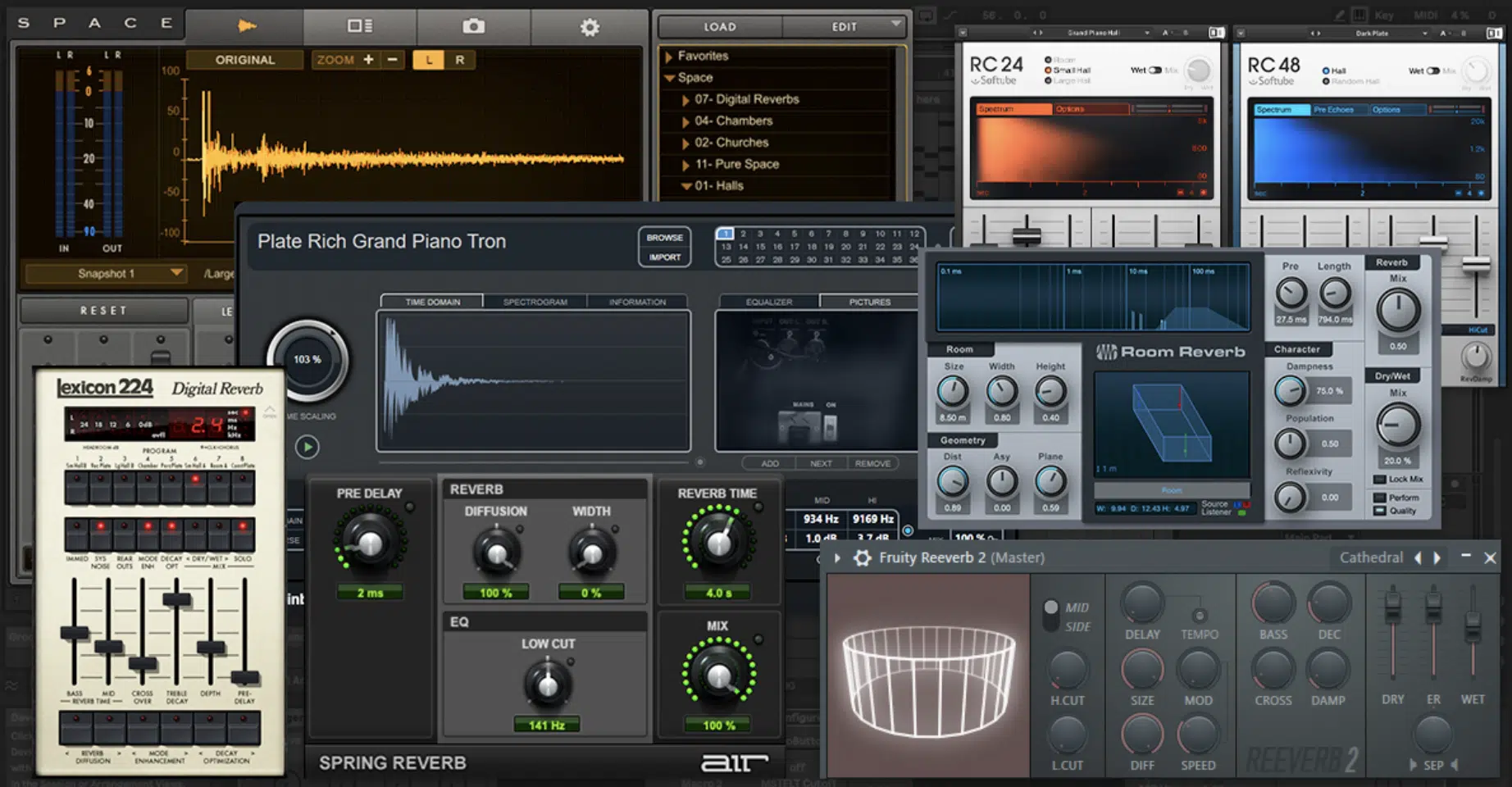
The world of reverbs is vast, offering various options to digital music producers.
Beyond digital reverbs, there’s an array of choices, each bringing a unique texture to your music.
#1. Spring reverb is a type of reverb effect that simulates the sound of reverberation in a physical space using a mechanical system.
This system typically consists of a set of springs, where sound is introduced at one end and captured at the other 一 creating a distinct, natural reverb effect.
#2. Plate reverb, for instance, known for its dense and smooth sound, is ideal for achieving a vintage vibe, often used in classic rock music and vocal tracks.
#3. Hall reverb, mimicking the expansive sound of large concert halls, adds a dramatic and spacious quality, perfect for orchestral or ambient tracks.
#4. Chamber reverb is another fascinating type of reverb, which replicates the sound of music played in a small, acoustically rich room.
This type of reverb adds a natural and warm quality to the sound, often used to enhance the richness of acoustic guitars or to add depth to a vocal recording.
#5. Room reverb, on the other hand, simulates the more intimate sound of smaller spaces. It is essential for adding a subtle sense of a specific space to your songs, without overwhelming the original sound.
#6. Convolution reverb, for those looking to experiment, offers a cutting-edge approach; it uses actual recorded spaces to create highly realistic reverbs.
This type of reverb can transport your sound to a specific space, from famous studios to unique outdoor environments, offering an unparalleled level of realism.
Different Types of Delays
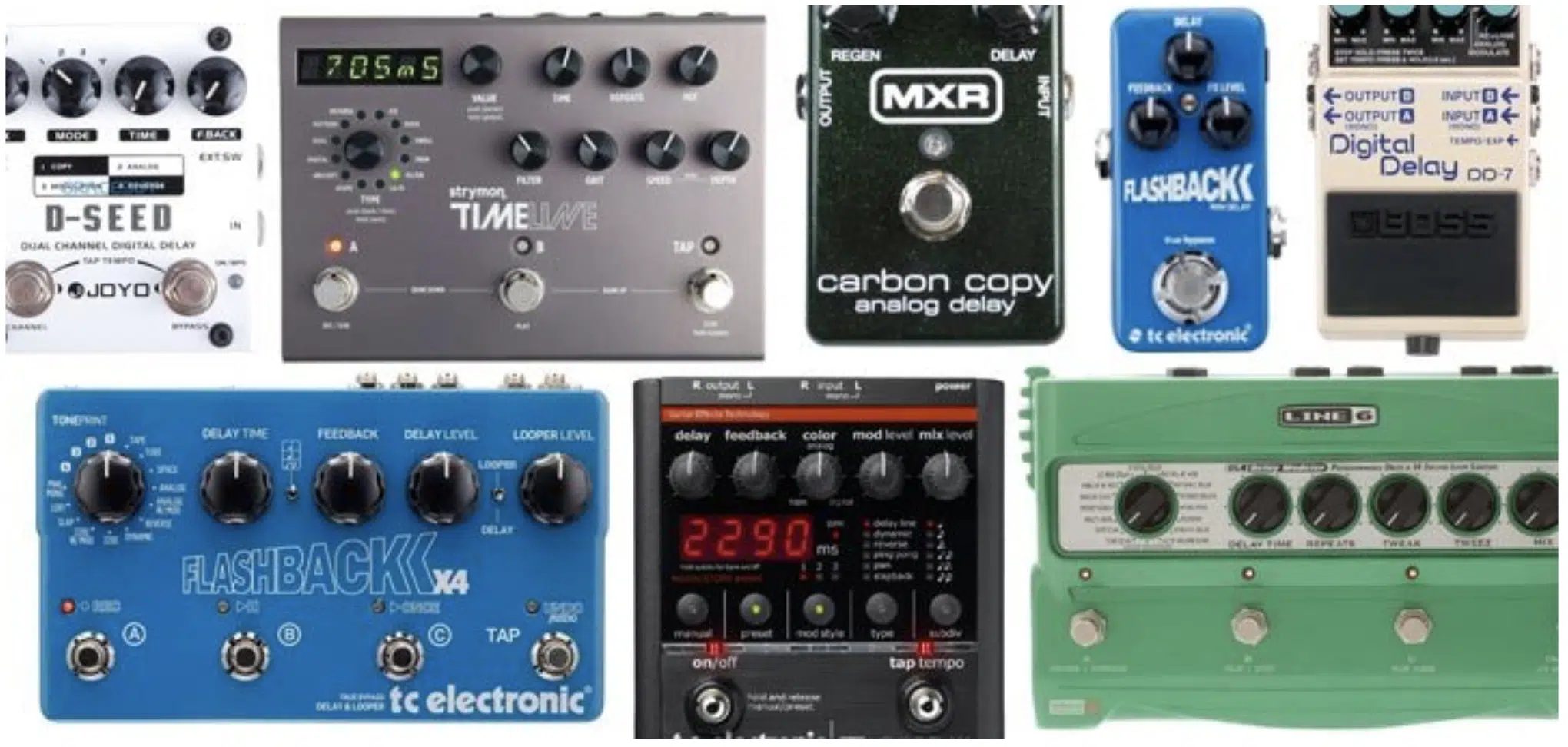
When it comes to delay types, each offers a unique twist to the basic concept.
Ping-pong delay, for instance, bounces the delayed signal from left to right in the stereo field, creating a dynamic and engaging effect.
This type of delay can breathe life into a static mix, adding a sense of movement and excitement.
It’s particularly effective in electronic and ambient music, where spatial effects are key.
Analog and digital delays also present distinct characteristics.
- Analog delays, known for their warm and organic sound, use physical components to create echoes. These tend to have a more natural decay, often preferred in rock music and guitar sounds.
- Digital delays, in contrast, offer pristine and clear repetitions, allowing for more precise control over the delay time and feedback. They are versatile and can be used in all genres, from pop to experimental music.
Another fascinating type is the tape delay, which emulates the sound of old tape machines.
This type of delay adds a vintage character to the sound, often introducing a subtle modulation that can enrich electric guitars or vocal tracks.
The charm of tape delay lies in its imperfections, such as the slight warble and degradation of the echo, which can add character and add depth to a mix.
Reverb vs Delay: The Key Differences
Understanding the fundamental differences between reverb and delay is crucial for any innovative music producer.
While both are time-based effects, they interact with sound in distinct ways that can significantly add texture and depth to your track.
So, let’s break down each difference between reverb and delay so you can know whether to use delay or reverb for a specific purpose.
-
Reverb
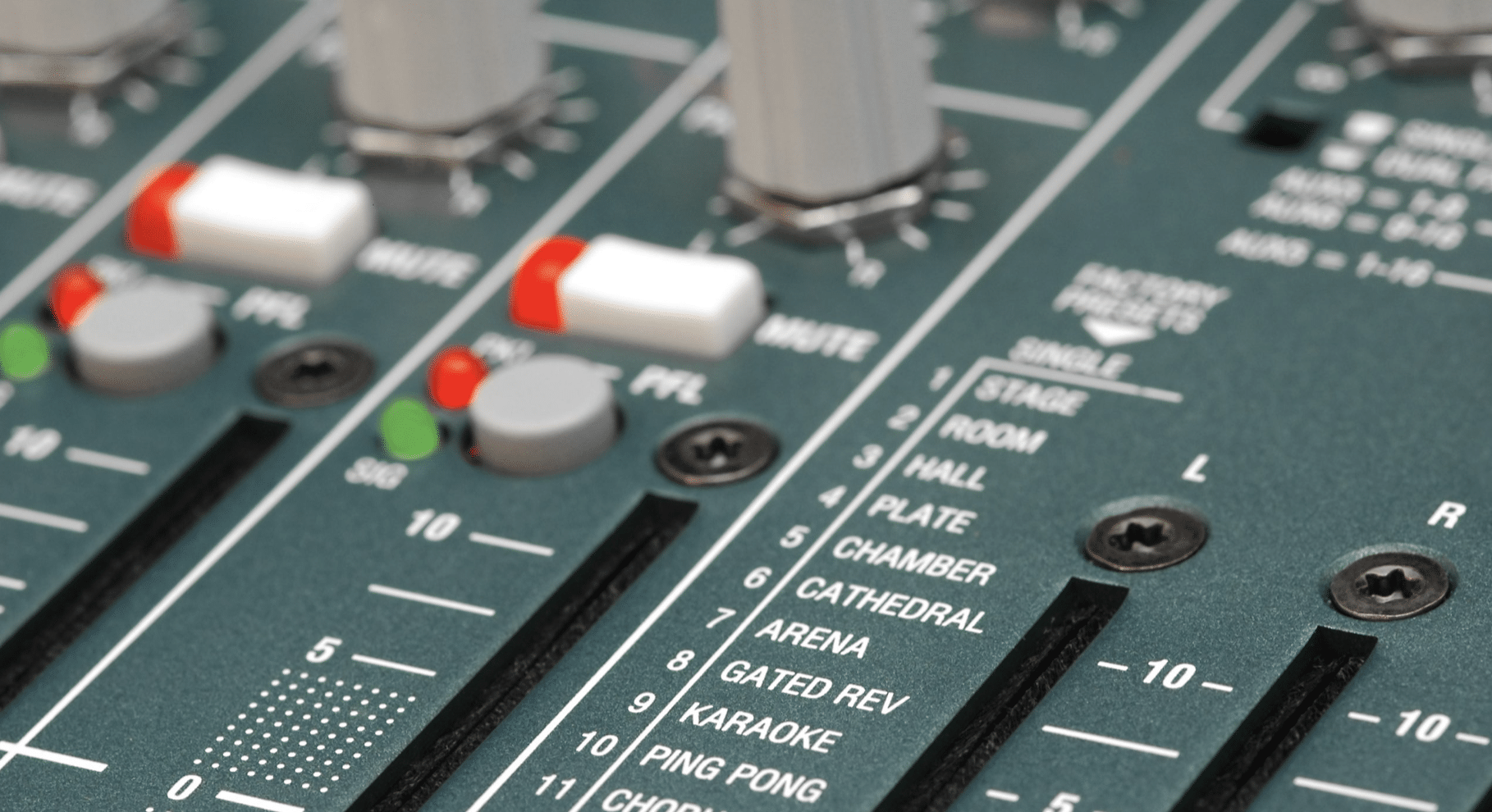
Reverb creates a sense of space, making the sound feel like it’s part of an environment.
This audio effect ranges from the subtle ambiance of a small room to the grandeur of a large hall.
The key aspect of reverb is its ability to blend the sound into these simulated spaces, creating a sense of depth and context.
-
Delay
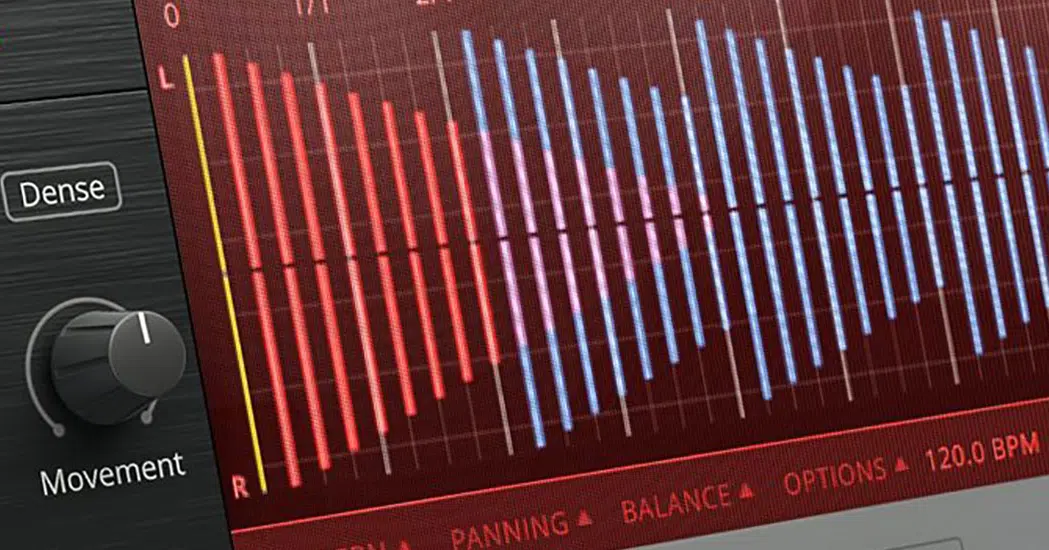
Delay, by contrast, works by repeating the original sound at set intervals, creating echoes.
These repetitions can be adjusted in terms of:
- Delay time
- Feedback
- Volume
Therefore, allowing for a wide range of effects 一 from a simple echo to complex rhythmic patterns.
Unlike reverb, which is about creating a space, delay is about playing with time, offering a more direct and noticeable alteration of the sound.
The choice between reverb and delay often depends on the desired outcome in the mix.
Reverb can be used to add depth and fullness to a track, making it feel more alive and realistic.
Delay, on the other hand, can be used to add rhythmic interest or to highlight other elements of a track.
NOTE: Both effects can be used together, but understanding (and playing around with) their characteristics is key to using them effectively.
Physical Space vs Time-based Effects

Reverb, in essence, replicates the physical space in which a sound could exist.
It simulates how sound waves behave in different environments, from small rooms to large cathedrals.
This effect is achieved by creating a series of closely spaced echoes that merge into a smooth decay.
It gives the listener a sense of the size and texture of the space (without causing any smearing problems or distortion).
The concept of physical space when playing around with reverb is crucial.
Whether it’s a digital reverb simulating a specific environment or a spring reverb adding a particular coloration, the idea is to make the sound feel like it exists in a real, tangible space.
This spatial simulation can greatly enhance the emotional impact of a song 一 giving your song a sense of place and context.
Delay, conversely, is inherently a time-based effect.
It works by taking the original sound and repeating it after a set period, defined by the delay time.
This creates echoes that can vary from tight, rapid repeats to longer, more spaced-out ones.
Unlike reverb, which aims to create a sense of space, delay focuses on manipulating the time aspect of sound.
Strategies for Blending Reverb and Delay in a Mix
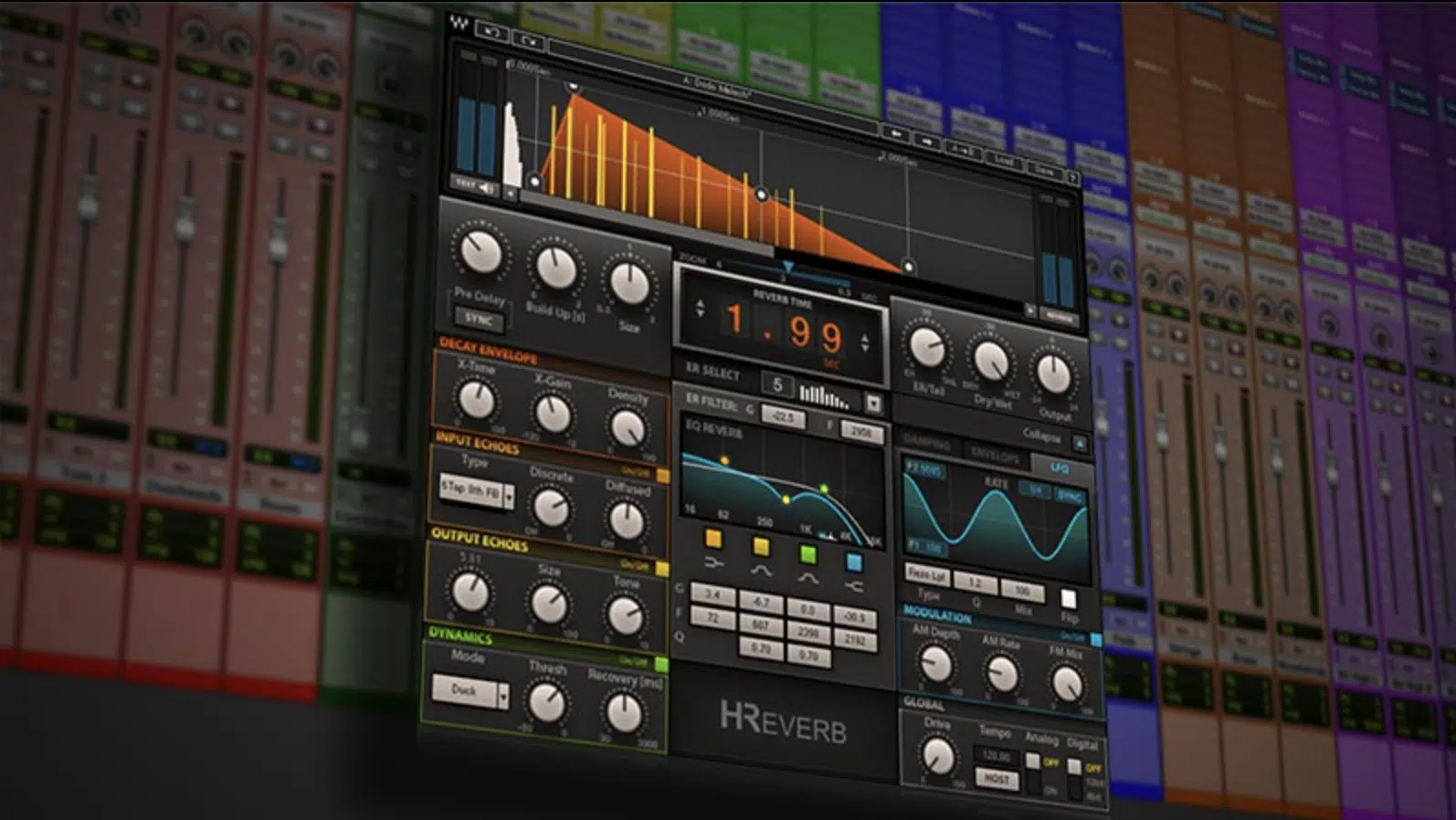
When combining reverb and delay in a mix, balance is essential.
A common approach is to use reverb to create a sense of space and delay to add rhythmic or textural elements.
For example, you can use:
- A hall reverb 一 To give a vocal track a sense of grandeur.
- A subtle delay 一 To give your guitar part a more enhanced rhythmic feel.
The key is to ensure that one effect does not overpower the other and that they both contribute to the desired atmosphere and texture of the track.
Another effective strategy is to use the two effects in a complementary manner.
For instance, a short slapback delay can add presence to a vocal, while a gentle room reverb provides a sense of natural space around it.
Alternatively, for guitar solos, a ping-pong delay can create a sense of movement, while a spring reverb adds depth and character.
Experimenting with different combinations and settings can help you play unique and captivating results, exceeding what you could imagine.
Understanding Reverb and Delay Settings
The various settings of reverb and delay play a crucial role in defining their impact on the sound.
For true reverb, key settings include:
- Room size 一 Determines the size of the simulated space. It affects how the sound waves are perceived to bounce around the same space it’s emulating.
- Decay time 一 Controls how long the reverb lasts.
- Wet/dry mix 一 The wet/dry signal sets the balance between the original signal and the reverb effect.
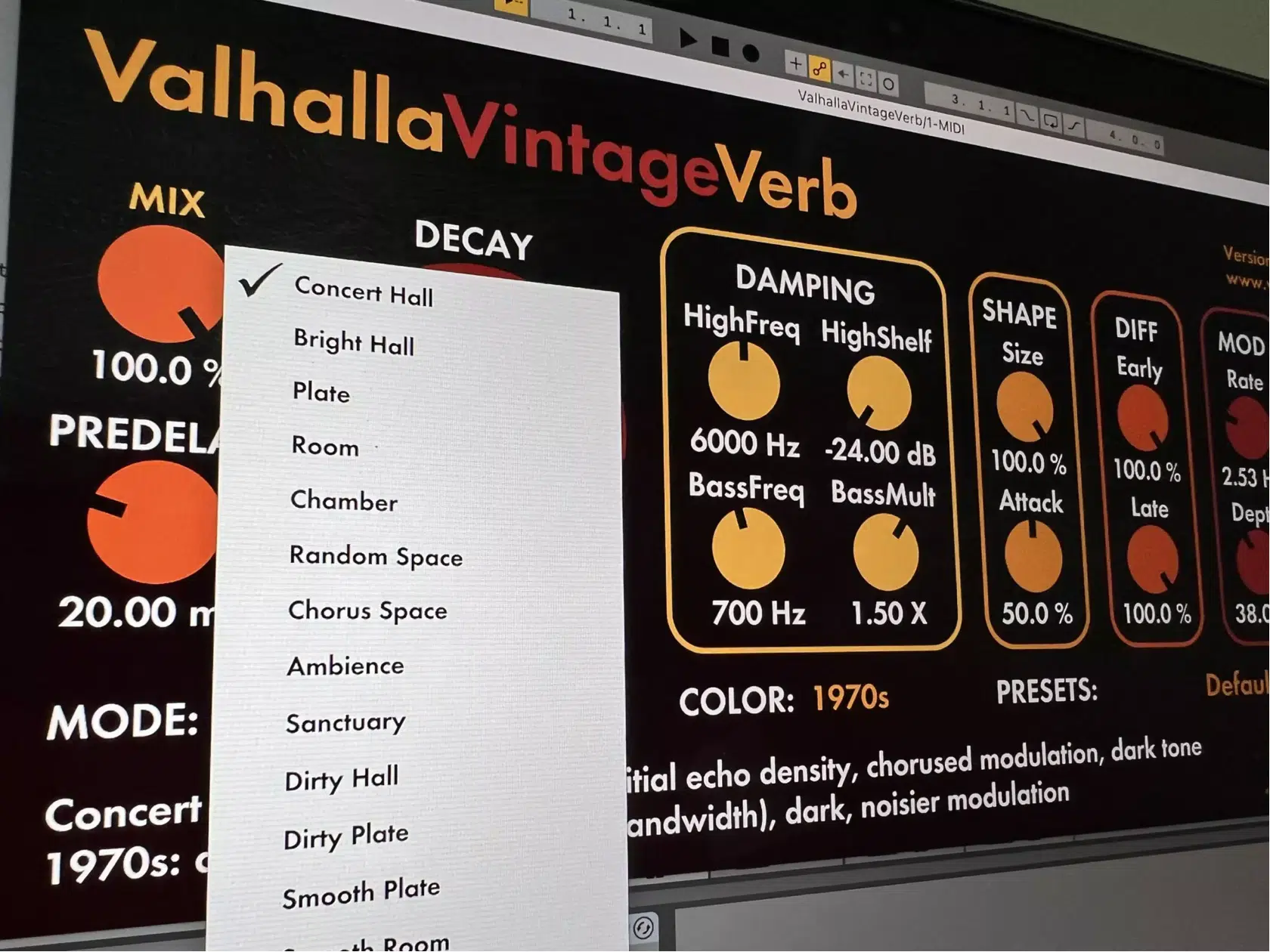
Understanding, and playing around with these settings allows for precise control over how the reverb interacts with the sound.
Delay settings are equally important and include:
- Delay time 一 Determines the interval between the original sound and its echo, a crucial factor for creating rhythmic patterns or a specific mood.
- Feedback 一 Controls how many times the delayed sound is repeated, essential for everything from a single slapback echo to a cascading series of repeats.
- Mix 一 Balances the original signal with the delayed one, allowing you to blend (and hear) the effect seamlessly into your track.
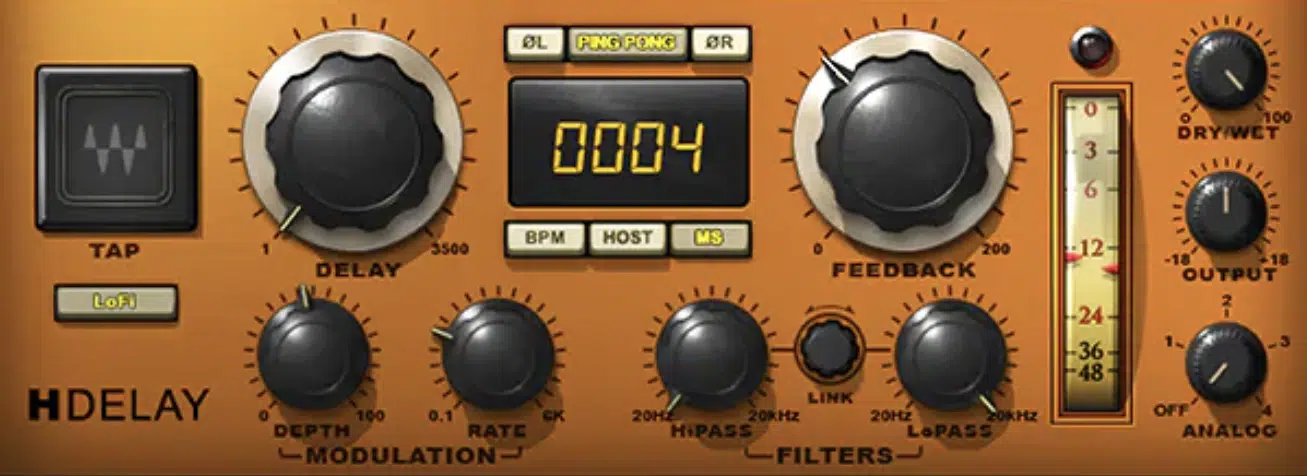
Mastery of these settings is key to using delay effectively, whether you’re working with a delay pedal, delay plugins, or hardware units.
NOTE: Both reverb and delay settings can be finely tuned to suit different musical contexts.
In a recording session, for instance, a longer reverb decay might be used to create a dramatic, expansive atmosphere for a vocal track.
Conversely, while playing live, a shorter decay might be more suitable to maintain clarity.
Similarly, delay time can be synced to the tempo of a song to create rhythmic cohesion, a technique often used in EDM and Dance music to tie delay effects closely to the beat.
Delay Plugins
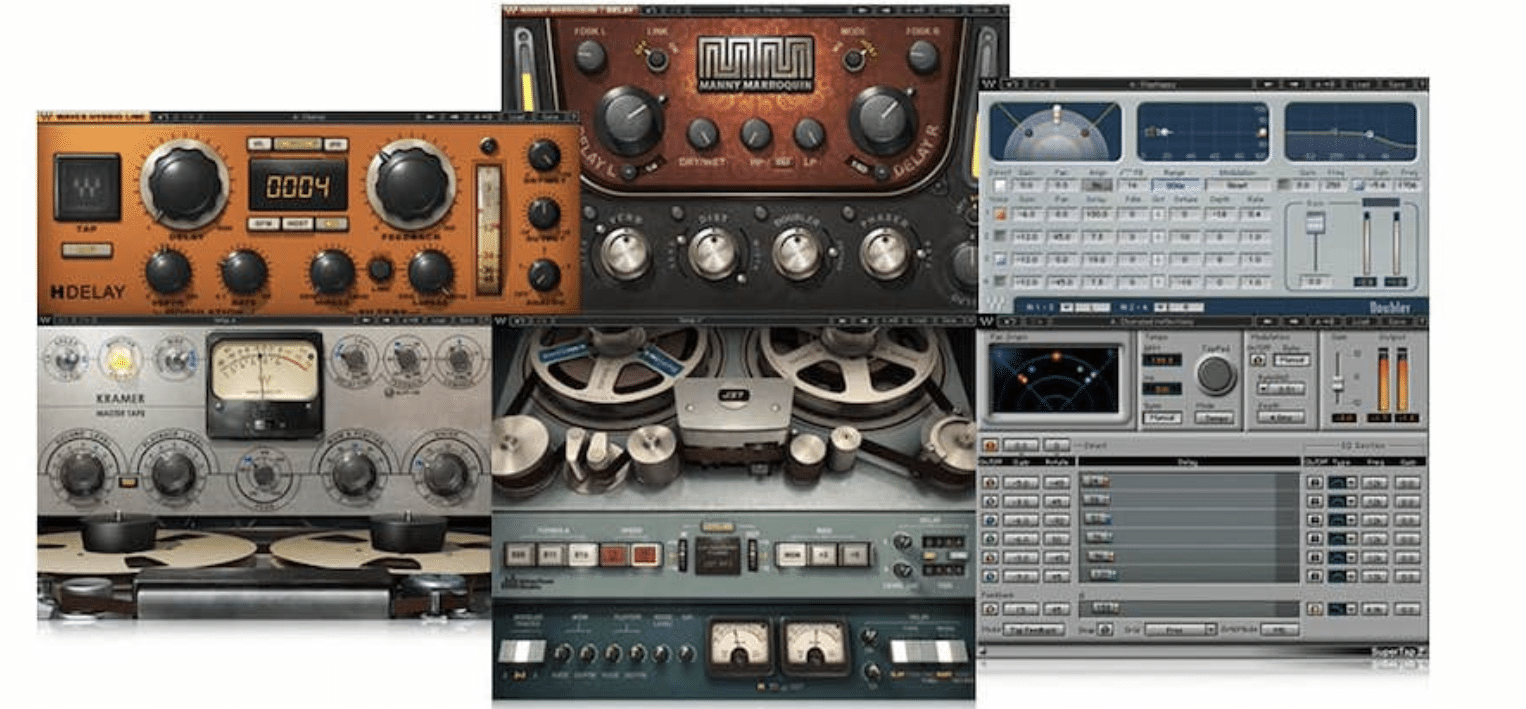
Delay plugins offer a digital solution for applying delay effects in music production.
These delay plugins range from simple, straightforward designs to complex ones with multiple parameters for detailed control.
Many delay plugins mimic the characteristics of classic hardware units.
Therefore, providing the warmth and character of analog delay with the convenience and precision of digital control.
They can be a valuable tool for creating everything from subtle ambient textures to prominent rhythmic patterns.
The advantage of using delay plugins lies in their flexibility and integration with digital audio workstations (DAWs).
They allow producers to automate changes in delay time, feedback, and mix 一 creating dynamic shifts in the delay effect throughout a track.
Additionally, modern delay plugins often include additional features such as modulation, filtering, and stereo width control.
If you’d like to check out the best delay plugins in the game, we’ve got you covered.
Digital Reverbs & Reverb Effects
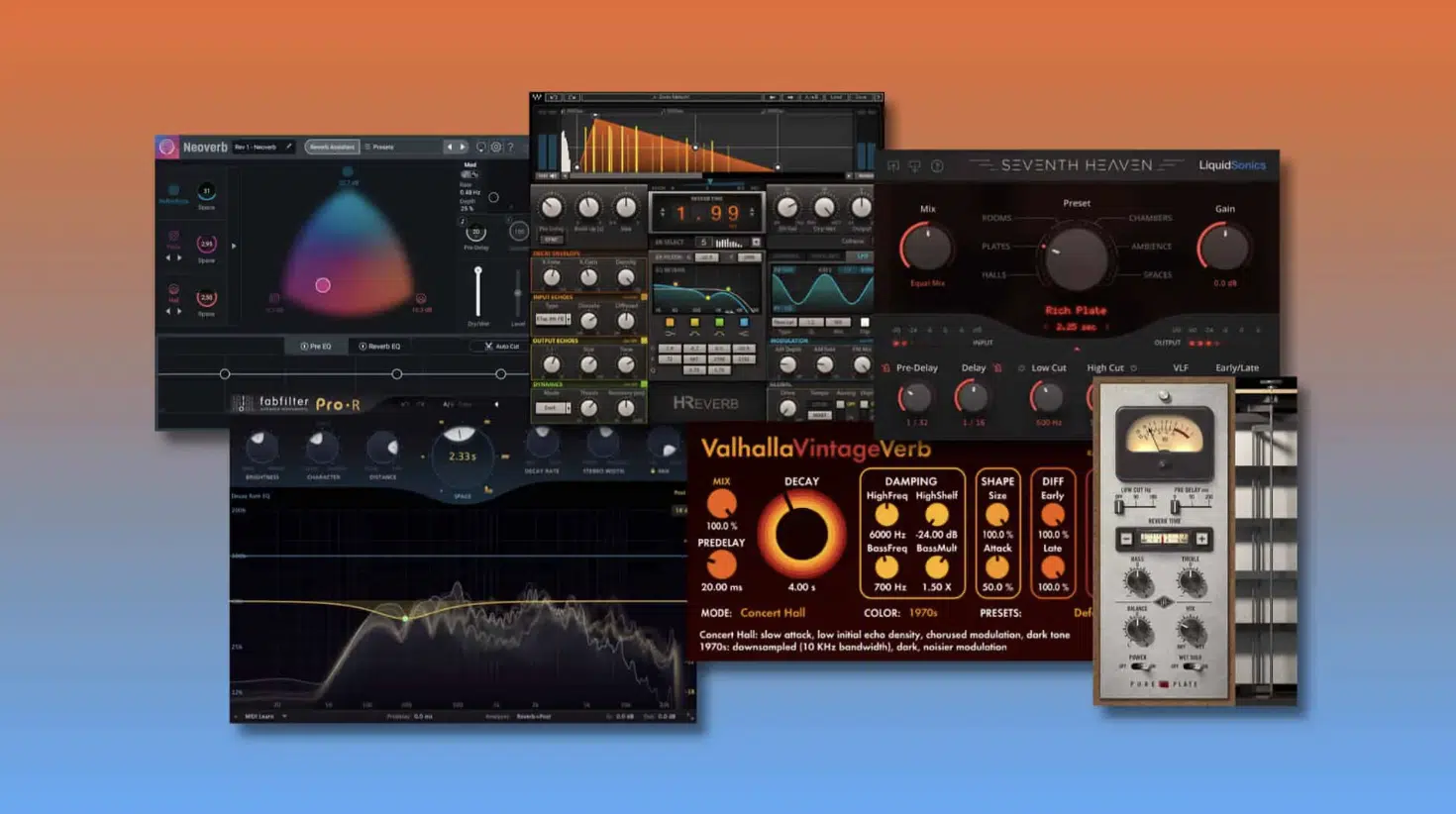
Digital reverbs have revolutionized the way you can add space and depth to your tracks or songs.
These reverb effects range from realistic simulations of physical spaces to more abstract, creative reverbs that add texture that is unique.
Digital reverbs provide an array of settings, allowing you to finely sculpt the reverb character 一 from the size of the space to the tone of the reverb tail.
The versatility of digital reverbs makes them ideal for a variety of applications in music production.
They can be used to create a sense of place, like a large room or a cathedral.
Or, to add a specific character to an instrument, like a lush hall reverb on a vocal track or a tight room reverb on a drum kit.
The ability to adjust certain parameters gives you precise control over how the reverb interacts with the original sound, like:
- Pre-delay
- Diffusion
- Damping
In addition to traditional reverb effects or reverb pedal, many digital reverbs offer innovative features you can play around with.
For example, convolution reverb uses impulse responses to replicate the acoustics of real spaces.
This technology allows your audience to hear incredibly realistic and immersive reverb effects.
Whether used subtly for a specific moment, or as a prominent effect, digital reverbs are truly invaluable.
If you’re looking for the best reverb plugins in the game, we’ve got you covered.
How To Tailor Effects to Different Instruments: Guitar, Voice, etc.
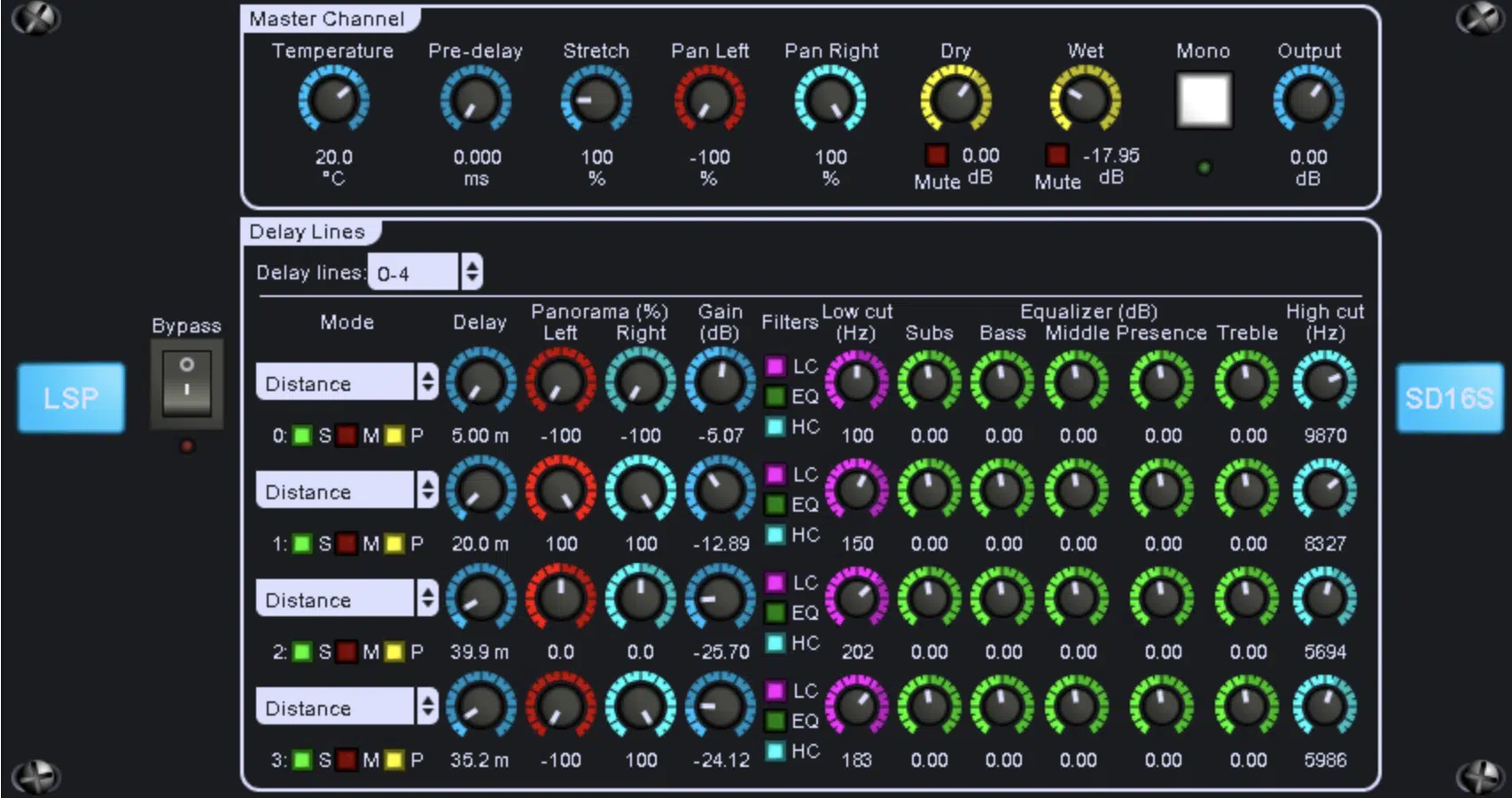
When applying reverb and delay effects, it’s essential to tailor them to suit the specific instrument or voice in the mix.
For guitar, a true reverb pedal can add dimension and atmosphere to the sound.
Whether it’s a subtle room reverb for rhythm parts or a lush hall reverb for solos, a reverb pedal is invaluable.
Aside from a reverb pedal, a delay pedal can also be used to enhance guitar playing, with:
- A short slapback delay 一 Adding presence.
- A longer delay 一 Creating a spacious, ambient effect.
Vocal tracks, on the other hand, require a different approach.
A touch of reverb can add warmth and depth to a voice, making it sit well in the mix (plus, it sounds epic).
It’s important to choose and experiment with the right type of reverb.
For example, a large room or hall reverb can add drama and space, while a plate reverb can provide a smooth, classic sound.
Delay can be used to add depth or to create rhythmic interest, but it should be applied carefully to your song to avoid muddying the vocals.
Each instrument or voice has its unique characteristics, and the effects should complement these.
NOTE: A subtle delay might work well on a piano to add a sense of space, while a more pronounced ping-pong delay could be effective on synthesizers to create a sense of movement.
3 Creative Techniques For Mastering Reverb and Delay
One effective technique for mastering reverb and delay is to use automation in your DAW (Digital Audio Workstation).
#1. Automate the Parameters of your Reverb and Delay Effects
Automating the parameters of your reverb and delay effects can add dynamic movement to your mix.
For instance, you can automate the reverb decay on a vocal track to increase during a chorus for a more dramatic effect.
Or, automate the feedback of a delay on a guitar part during a solo to enhance its impact.
This delay/reverb technique allows for precise control and can add a professional polish to your track, heard in songs that top the charts.
#2. Layer Different Types of Reverb and Delay.
Another delay/reverb technique is to layer different types of reverb and delay.
For example, combining a spring reverb with a digital delay can create a unique texture on a guitar track.
Or, layering a hall reverb with a subtle delay on a vocal can add both spatial depth and rhythmic interest.
Layering these effects requires a careful balance to ensure they complement rather than compete with each other.
#3. Play Around with Unconventional Delay/Reverb Settings
Playing around with unconventional delay/reverb settings is another great technique.
For example, setting a very short reverb time with a high wet mix can create an ambient, otherworldly effect you can instantly hear in your song.
It’s ideal to help you achieve new sounds or textures.
Similarly, using extreme settings on a delay pedal (like a very short delay time with high feedback) can produce unusual and creative rhythmic patterns.
This is especially effective in genres like electronic or experimental music.
Reverb vs Delay: Final Thoughts

Understanding the unique qualities of reverb vs delay is crucial for any music producer.
These effects can shape the atmosphere and rhythm of your tracks, from adding depth with a hall reverb to creating movement with a ping-pong delay.
They’re the tools that transform a simple melody into an immersive experience and a basic rhythm into a captivating beat.
If you’re looking to put these effects into effect (no pun intended), you’ve got to check out Sound Doctor.
This innovative plugin offers an array of reverbs and delays, among other effects, to elevate your music production.
With its ability to generate complex FX chains at the click of a button, it’s a game-changer for those looking to explore the depths of reverb vs delay and beyond.
Sound Doctor could be the key to unlocking new levels of creativity in your work and master different audio effects.
Plus, it can help you to craft sounds that stand out in the competitive world of digital music production.
So, with your new knowledge and this invaluable plugin, you can go and create show-stopping tracks that will top the charts.
Until next time…







Leave a Reply
You must belogged in to post a comment.